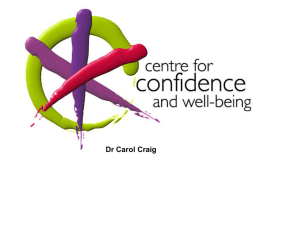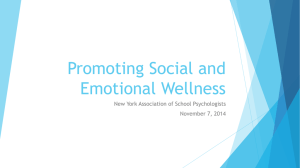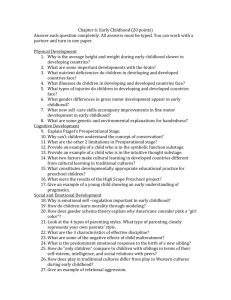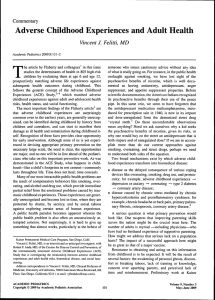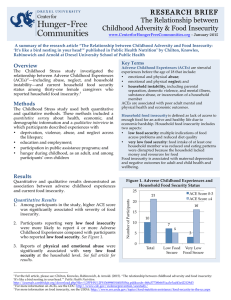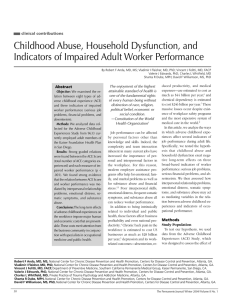Dr. Shonkoff's Presentation - Westchester Children's Association
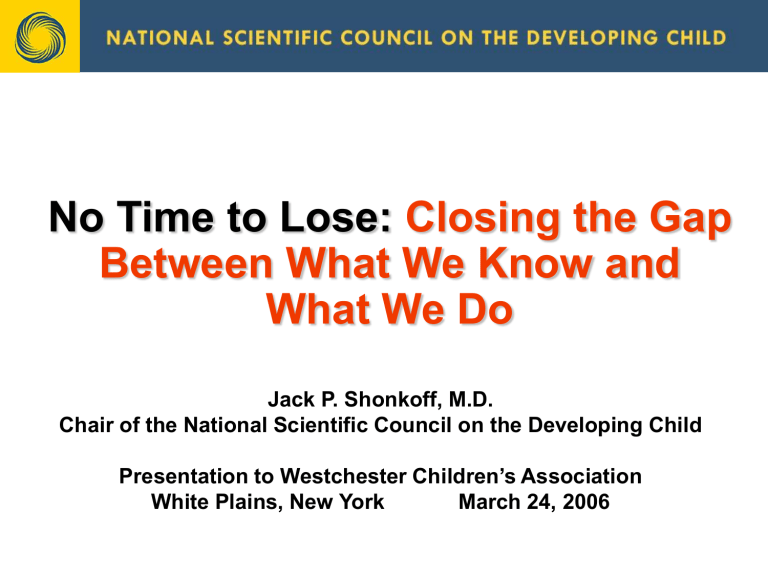
No Time to Lose: Closing the Gap
Between What We Know and
What We Do
Jack P. Shonkoff, M.D.
Chair of the National Scientific Council on the Developing Child
Presentation to Westchester Children’s Association
White Plains, New York March 24, 2006
The Importance of Viewing the Needs of Children in a Broad Context
The healthy development of all young children benefits all of society by providing a solid foundation for responsible citizenship, economic productivity, lifelong physical and mental health, strong communities, and sustainable democracy and prosperity.
What We Know About Brain Development
• Brains are built over time, shaped by the interaction between genetics and experience.
• Social, emotional, and cognitive development are highly interrelated.
• Brain architecture and skills are built in a hierarchical “bottom-up” sequence.
• Brain plasticity and the ability to change behavior decrease over time.
At Birth 6 Years Old 14 Years Old
Rethinking the Brain, Families and Work Institute, Rima Shore, 1997.
Relationships are the “Active
Ingredients" of Early Experience
• Nurturing and responsive relationships build healthy brain architecture that provides a strong foundation for learning, behavior, and health.
• When protective relationships are not provided, elevated levels of stress hormones (i.e., cortisol) disrupt brain architecture by impairing cell growth and interfering with the formation of healthy neural circuits.
Early Childhood Adversity Can Have
Lifelong Consequences
Research on the biology of stress helps explain some of the underlying reasons for differences in learning, behavior, and physical and mental health.
Positive Stress
• Moderate, short-lived stress responses, such as brief increases in heart rate or mild changes in stress hormone levels.
• Precipitants include the challenges of meeting new people, dealing with frustration, getting an immunization, or adult limit-setting.
• An important and necessary aspect of healthy development that occurs in the context of stable and supportive relationships.
Tolerable Stress
• Stress responses that could disrupt brain architecture, but are buffered by supportive relationships that facilitate adaptive coping.
• Precipitants include death or serious illness of a loved one, a frightening injury, parent divorce, terrorism, a natural disaster, or homelessness.
• Generally occurs within a time-limited period, which gives the brain an opportunity to recover from potentially damaging effects.
Toxic Stress
• Strong and prolonged activation of the body’s stress management systems in the absence of the buffering protection of adult support.
• Precipitants include extreme poverty, physical or emotional abuse, chronic neglect, severe maternal depression, substance abuse, or family violence.
• Disrupts brain architecture and leads to stress management systems that respond at relatively lower thresholds, thereby increasing the risk of stress-related physical and mental illness.
Data To Think About
5
4.5
4
3.5
3
2.5
2
1.5
1
0.5
0
Adverse Childhood Events and
Adult Depression
Adverse Events
2
3
0
1
4
5+
Chapman et al, 2004
Adverse Childhood Events and Adult
Ischemic Heart Disease
3.5
3
2.5
2
1.5
1
0.5
0
0
3
4
1
2
5,6
7,8
Adverse Events
Dong et al, 2004
%
10
8
6
4
2
16
14
12
0
Adverse Childhood Events and
Adult Substance Abuse
0 1 2 3 4+ 0 1 2 3 4 5+
%
40
35
30
25
20
15
10
5
0
Self-Report: Alcoholism Self-Report: Illicit Drug Use
Dube et al, 2002 Dube et al, 2005
Importance of Emotional Development
• In a study of 211 children under age 3 with newly opened child protection cases and completed developmental evaluations, 52% had documented delays or established conditions that met eligibility criteria for early intervention services in Massachusetts (MECLI, 2005).
• In a survey of 119 preschool teachers, 39% reported expelling at least one child from their program in the preceding year (Gilliam, 2004).
Economic Benefits of Early Intervention
• Perry Preschool Project follow-up data at age
40 indicate a total benefit-cost ratio of 17:1 (4:1 for participants and 13:1 for the public), with annual internal rates of return of 18% (1% participant gain and 17% public benefit).
• Participant benefits are derived largely from higher earned income.
• Public benefits include higher tax revenues and lower costs for special education, public assistance, and incarceration.
Implications for Policy and Practice
Human Capital Formation
Requires a Balanced Approach
If we really want to build a strong platform for healthy development and effective learning in the early childhood years… then we must pay as much attention to children’s emotional well-being and social capacities as we do to their cognitive abilities and academic skills.
Quality Interventions Make a Difference
Services for vulnerable, young children can have positive impacts on brain development that generate a significant return on investment over a lifetime...
but they require the quality and sustainability that comes from low staff turnover and well trained personnel with expertise that matches the needs of the children and families served.
Neuroscience Applies to Policies
Beyond Early Care and Education
If we really want to promote better outcomes for children, then we must apply the science of early childhood and early brain development to a broad array of policies … including welfare reform, adult mental health, child welfare, family and medical leave, and environmental protection, among others.
Young Children and their
Families Need New Champions
Need for fresh leadership in both the public and private sectors to address significant inequalities in opportunity for children, beginning in the earliest years of life, as both a moral responsibility and a critical investment in the nation’s social and economic future.
www.developingchild.net


